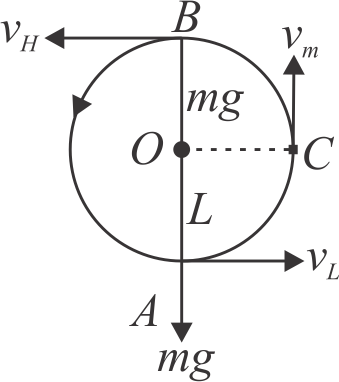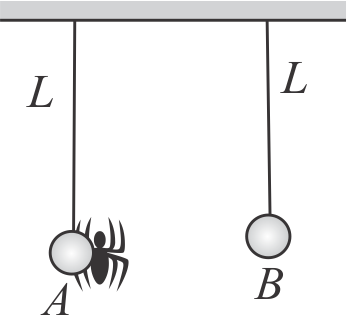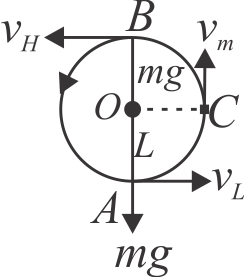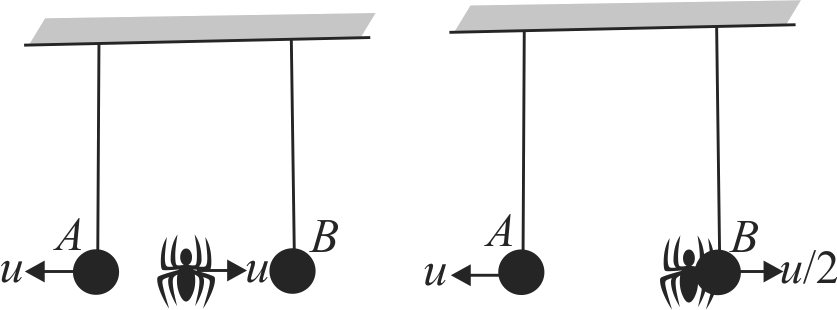355707
A bob of mass ' \(m\) ' is suspended by a light string of length ' \(L\) '. It is imparted a minimum horizontal velocity at the lowest point \(A\) such that it just completes half circle reaching the top most position \(B\). The ratio of kinetic energies \(\frac{{{{({\rm{ }}K.E.{\rm{ }})}_A}}}{{{{({\rm{ }}K.E.{\rm{ }})}_B}}}\) is
355709
An insect jumps from ball \(A\) onto ball \(B\). which are suspended from inextensible light strings each of length \(L=8 {~cm}\). The mass of each ball and insect is same. What should be the minimum relative velocity of jump of insect w.r.t. ball \(A\), if both the balls manage to complete the full circle?
355707
A bob of mass ' \(m\) ' is suspended by a light string of length ' \(L\) '. It is imparted a minimum horizontal velocity at the lowest point \(A\) such that it just completes half circle reaching the top most position \(B\). The ratio of kinetic energies \(\frac{{{{({\rm{ }}K.E.{\rm{ }})}_A}}}{{{{({\rm{ }}K.E.{\rm{ }})}_B}}}\) is
355709
An insect jumps from ball \(A\) onto ball \(B\). which are suspended from inextensible light strings each of length \(L=8 {~cm}\). The mass of each ball and insect is same. What should be the minimum relative velocity of jump of insect w.r.t. ball \(A\), if both the balls manage to complete the full circle?
355707
A bob of mass ' \(m\) ' is suspended by a light string of length ' \(L\) '. It is imparted a minimum horizontal velocity at the lowest point \(A\) such that it just completes half circle reaching the top most position \(B\). The ratio of kinetic energies \(\frac{{{{({\rm{ }}K.E.{\rm{ }})}_A}}}{{{{({\rm{ }}K.E.{\rm{ }})}_B}}}\) is
355709
An insect jumps from ball \(A\) onto ball \(B\). which are suspended from inextensible light strings each of length \(L=8 {~cm}\). The mass of each ball and insect is same. What should be the minimum relative velocity of jump of insect w.r.t. ball \(A\), if both the balls manage to complete the full circle?
355707
A bob of mass ' \(m\) ' is suspended by a light string of length ' \(L\) '. It is imparted a minimum horizontal velocity at the lowest point \(A\) such that it just completes half circle reaching the top most position \(B\). The ratio of kinetic energies \(\frac{{{{({\rm{ }}K.E.{\rm{ }})}_A}}}{{{{({\rm{ }}K.E.{\rm{ }})}_B}}}\) is
355709
An insect jumps from ball \(A\) onto ball \(B\). which are suspended from inextensible light strings each of length \(L=8 {~cm}\). The mass of each ball and insect is same. What should be the minimum relative velocity of jump of insect w.r.t. ball \(A\), if both the balls manage to complete the full circle?


